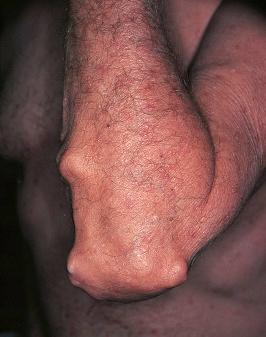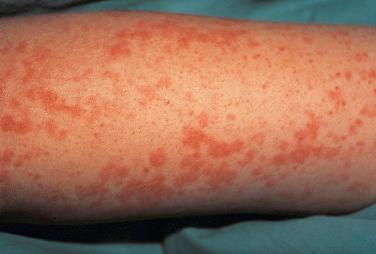Physical Address
304 North Cardinal St.
Dorchester Center, MA 02124
Rheumatoid arthritis (RA) is a multisystem disorder with many extra-articular manifestations that may affect the skin, including rheumatoid nodules and rheumatoid vasculitis.
Rheumatoid nodules are the most characteristic cutaneous manifestation of RA. They, along with other extra-articular manifestations, are most common among seropositive RA patients.
Systemic-onset juvenile idiopathic arthritis and adult-onset Still’s disease are diagnoses of exclusion that are characterized by intermittent fevers with an accompanying exanthem, arthritis, hepatosplenomegaly, lymphadenopathy, and nonspecific serologic findings.
Screening for underlying autoimmune disease and malignancy should be considered in patients with newly diagnosed interstitial granulomatous dermatitis or palisaded neutrophilic granulomatous dermatitis.
Kawasaki disease is a small-to medium-vessel vasculitis characterized by high fevers and a constellation of clinical findings most notably involving the skin and coronary vessels. Prompt therapy with combination intravenous immunoglobulin and high-dose aspirin is the treatment of choice to prevent coronary artery aneurysms.
Sjӧgren’s syndrome is an autoimmune condition that affects the secretory glands. Cutaneous manifestations include xerosis, cutaneous small-vessel vasculitis, urticarial vasculitis, cryoglobulinemic vasculitis, and hypergammaglobulinemic purpura. Patients are at increased risk for B-cell lymphomas.
Gout is caused by persistent elevation of serum uric acid levels leading to acute attacks of crystal-induced arthritis and chronic deposition of monosodium urate in the skin, joints, and surrounding synovium known as tophi.
Rheumatoid arthritis (RA) is a multisystem disease of unknown etiology, which is primarily characterized by synovitis that can lead to erosive joint deformity and significant morbidity. Extra-articular manifestations commonly involve the skin and/or the lungs, but may also involve the hematologic, cardiovascular, and neurologic systems. RA primarily affects females between the fourth and sixth decades of life, but can occur at all ages.
The diagnosis of RA is relatively easy to make in its advanced stages but is challenging early in the disease course. The diagnosis is based on a combination of clinical, radiographic, and laboratory findings, including the serum rheumatoid factor. Criteria have been developed by the American College of Rheumatology for the diagnosis of classic, definite, probable, and possible RA, as well as for determining clinical remission, disease progression, and the functional capacity of patients. Histologic changes in the synovium and the presence of skin nodules are additional criteria. The rheumatoid factor (RF), measured primarily as IgM with specificity against altered IgG, is positive in approximately 75% of patients with RA and in 5% to 10% of normal subjects. The presence of second-generation anticyclic citrullinated peptide is similar in sensitivity to RF, but is more specific at 90% to 95%. High levels of RF are generally associated with more severe, erosive forms of the disease, as well as with the presence of extra-articular manifestations including rheumatoid nodules and other associated skin disorders. HLA-DRB1 ∗ 04 is the most significant genetic association with seropositive RA. Additional confirmed genetic variants include peptidylarginine deiminase type 4 (PADI4) and protein tyrosine phosphatase nonreceptor type 22 (PTPN22). Interleukin (IL)-4 receptor single-nucleotide polymorphisms have been associated with increased risk of joint destruction and rheumatoid nodules.
A number of cutaneous findings are reported with RA. Few of these are characteristic for the disease, with the notable exception of the rheumatoid nodule. Pyoderma gangrenosum and a wide spectrum of vasculitic lesions may occur in patients with RA, but they occur more frequently in association with other disorders. There also are a wide variety of cutaneous changes associated with therapeutic agents used to treat RA ( Table 7-1 ).
| Neutrophilic and/or granulomatous skin lesions |
|
| Nail Changes |
|
| Vasculopathic/Vasculitic Lesions |
|
| Leg Ulcers |
|
| Miscellaneous Associations |
|
| Skin Changes Secondary to Medications |
|
Rheumatoid nodules are firm, nontender, mobile subcutaneous nodules that occur in 20% to 35% of adult patients with RA. The incidence can be as high as 75% in those with Felty’s syndrome, a disorder characterized by resistant leg ulcers, granulocytopenia, and splenomegaly in the setting of seropositive RA. Rheumatoid nodules are the most characteristic cutaneous manifestation of RA, most commonly seen in white males with severe arthritis, high-titer RF seropositivity, and rheumatoid vasculitis. Smokers are more likely to have rheumatoid nodules. Rheumatoid nodules have also been reported in association with other entities including lupus erythematosus/rheumatoid arthritis overlap and antiphospholipid syndrome.
The dome-shaped flesh-colored nodules vary from 0.5 cm to several centimeters in diameter and tend to occur on the extensor extremities, usually overlying bony prominences that are frequently subjected to trauma ( Fig. 7-1 ). Any subcutaneous site can be affected, however, and histologically identical lesions have been found in the sclerae, larynx, heart, lungs, and abdominal wall. Rheumatoid nodules can cause discomfort, be disfiguring, and interfere with activities of daily living. Larger nodules can cause compressive neuropathies and are at risk for ulceration and secondary local infection. Eruptive rheumatoid nodules have been reported with the administration of methotrexate (“methotrexate accelerated nodulosis”), and less commonly with tumor necrosis factor (TNF) antagonists, azathioprine and leflunomide. The clinical differential diagnosis of rheumatoid nodules includes gouty tophi, xanthomas, deep (subcutaneous) or nodular granuloma annulare, subcutaneous sarcoidosis, and ganglion and epidermal inclusion cysts.

Histologically, three distinct zones are observed in well-developed rheumatoid nodules: a central zone of fibrinoid necrosis, a middle zone of palisading histiocytes, and a peripheral zone of highly vascularized granulation tissue with a chronic, mononuclear inflammatory cell infiltrate. Early lesions are composed primarily of granulation tissue but have focal areas of leukocytoclastic vasculitis that are believed to be relevant in the pathogenesis of the nodules. The histopathologic differential diagnosis includes the transient nodules seen in acute rheumatic fever, deep granuloma annulare, and necrobiosis lipoidica diabeticorum.
The spectrum of clinical lesions reported to be rheumatoid vasculitis is wide and varies with the size and location of the vessels involved, and with the extent of the disease. Leukocytoclasis occurs most commonly in the small arterioles and venules of the skin, but this same necrotizing process may occur in larger vessels of the mesentery, heart, and central nervous system. Most evidence suggests that the vasculitic lesions are related to circulating immune complexes. Cutaneous lesions include petechiae, capillaritis (pigmented purpuric dermatoses), palpable purpura, digital infarcts, retiform purpura, and large ischemic ulcerations of the lower extremities, especially over the malleoli. Vasculitis develops late in the disease course in patients with high-titer RF, severe erosive disease, and rheumatoid nodules. Although it has been reported to occur in only 2% to 5% of individuals with RA, rheumatoid vasculitis has been noted in up to 30% of patients on autopsy.
The cutaneous lesions of mild rheumatoid vasculitis include small digital infarcts, especially of the nail folds and digital pulp (often called Bywater’s lesions), petechiae, and livedo reticularis or livedo racemosa. Palpable purpura of the lower extremities and buttocks is typical in moderate disease, and is clinicopathologically indistinguishable from cutaneous small-vessel vasculitis due to other causes. Severe disease can occur in an explosive fashion, involving both the skin and systemic organs and having a mortality rate approaching 30%. Cutaneous involvement may include the changes seen in mild or moderate rheumatoid vasculitis, in addition to large ulcers from retiform purpura and digital gangrene. It is associated with a high degree of mortality so aggressive work-up with skin biopsy, serologic assessment, rheumatologic consultation, and rapid therapeutic intervention is merited. It is also important to consider the possibility of drug-induced cutaneous vasculitis in patients receiving biologic treatment for RA. Several biologic agents, infliximab in particular, have been associated with the development of cutaneous small-vessel vasculitis.
Several nonspecific cutaneous lesions and nail changes have been reported in patients with RA ( Table 7-1 ). In addition, there are numerous reports linking RA to pyoderma gangrenosum, as well as rheumatoid neutrophilic dermatitis, Sweet’s syndrome, interstitial granulomatous dermatitis, palisaded neutrophilic granulomatous dermatitis, connective tissue-associated panniculitis, erythema nodosum, and blistering diseases, particularly epidermolysis bullosa acquisita.
Juvenile idiopathic arthritis (JIA), previously termed juvenile rheumatoid arthritis, is characterized by the onset of arthritis in childhood to young adulthood and is classified into seven subtypes. Systemic-onset JIA, or Still’s disease, makes up 15% to 20% of JIA cases. Children with systemic-onset JIA display a characteristic evanescent, pink to salmon-colored urticarial or morbilliform eruption of the trunk or extremities associated with high, spiking fevers, which can precede the associated arthritis ( Fig. 7-2 ). The cutaneous eruption is asymptomatic and exhibits a predilection for the axillae and waist. Rarely, koebnerized, linear lesions can occur. The cutaneous eruption and fever are typically transitory and usually peak in the late afternoon to early evening. However, these symptoms may persist for several days. Patients typically have a polyarthritis of the hips, knees, ankles, wrists, and temporomandibular joints, which rarely may become erosive. Lymphadenopathy, serositis, and hepatomegaly can be seen. Laboratory findings are often unhelpful when diagnosing Still’s disease as >95% of patients have a negative RF and antinuclear antibody (ANA). However, significant hyperferritinemia (>4000 mg/mL) in addition to elevated acute-phase reactants, leukocytosis, anemia, and thrombophilia have been noted. Mortality has been linked to macrophage activating syndrome (MAS) that is characterized by an unremitting fever, cytopenias, coagulopathies, low sedimentation rate, and evidence of end-organ dysfunction. MAS can be triggered by underlying disease flare, medications or infections, and should be promptly diagnosed to avoid life-threatening multiorgan failure.

Become a Clinical Tree membership for Full access and enjoy Unlimited articles
If you are a member. Log in here